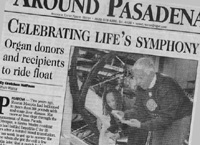

 |
|
|
23 Rose Parade® Float Riders Show Lives Transformed Through Organ, Tissue Donation; Nationwide Coalition of Organizations Unite To Inspire Everyone to Donate Life; First Step Can Be Gift of ‘Family Circle’ Rose on Donate Life Float LOS ANGELES, CA, October 14, 2005 – Most of the 23 riders who will wave from this year’s Donate Life Rose Parade® Float may seem at first like ordinary people, but they are heroes in their own lives. These are the men, women, and teens who have been selected from 13 states and the District of Columbia to represent the thousands of donor family members, living donors, and organ and tissue recipients whose lives embody the float’s theme, Life Transformed. “For the 90,000 people now waiting for life-saving organs, the presence of these riders shows that their hopes can be realized when people give the gift of life,” stated Bryan Stewart, chairman of the Donate Life Rose Parade Float organization committee and director of communications for OneLegacy, the non-profit, federally designated transplant donor network serving the greater Los Angeles area. “Everyone who has been touched by organ or tissue donation experiences a transformation in their life. In a year in which the parade theme is It’s Magical, our riders’ stories show the magic of a life transformed by donation." The float’s 23 riders are unique in age, ethnicity, gender, and home states: Arizona, California, Colorado, District of Columbia, Florida, Illinois, Indiana, Minnesota, Mississippi, New Mexico, New York, Ohio, Oklahoma, and Pennsylvania. Yet some will find common ground because they ride in memory of loved ones, like Robin Barrett, Gail Brooks, Edith Gonzalez, Kade Howard, Tae Park, Colleen Sasso and Mary Ann Venturelli. Some, like Christine Galan, who was the first heart-liver recipient to run the New York City Marathon, will be able to give tips to fellow rider Sahra Torres-Rivera, a living donor who will run a marathon in Arizona next year in honor of the friend who received her kidney. America Leyva will recognize Avery Livingston, because they both suffered renal failure at age 10 but are now happy 15-year-olds thanks in large part to kidney transplants. And Nicole Brooke Stoe, who celebrates 15 years after receiving a liver transplant at age 16, will be able to tell teen Kurt Wiltcher, who underwent his own liver transplant at 16, how bright his own future can be. The full list of riders includes:
Nearly 90,000 Americans currently await organ transplants, while every year hundreds of thousands of people need donated tissue to prevent or cure blindness, heal burns or save limbs. Each day, 17 people die awaiting a life-saving organ transplant. In addition to the 23 float riders, for the first time, anyone can participate directly in the Donate Life Float through the inaugural “Family Circle” program, which invites families and individuals touched by donation and transplantation to dedicate a rose on the float. Dedicated roses will be placed in the “Family Circle Garden” in water-filled vials, each one tagged with the name of an organ/tissue donor, transplant recipient, transplant candidate or other person touched by donation for whom the rose is dedicated. Complete details about dedicating a “Family Circle” rose can be found at www.donatelifefloat.net. In a salute to the importance the Hispanic community in organ and tissue donation and the nation, the logos on each side of the Donate Life float will be presented both in English and in Spanish (“Done Vida”) – a first in the 117-year history of the Tournament of Roses. This year’s riders are supported by more than 50 organizations nationwide that have joined forces to bring awareness of the growing need for organ and tissue donation and the importance of making the commitment to donate life. The partnership includes organ and tissue recovery organizations, transplant centers, transplant recipient groups and other organizations. Joining OneLegacy as top-level benefactors are Astellas Pharma US, Inc. and the United Network for Organ Sharing (UNOS). The 117th Rose Parade, themed It’s Magical, will take place on Monday, January 2, 2006 at 8:00am PST featuring spirited marching bands from throughout the nation, majestic floral floats and high-stepping equestrian units. For information call Rivian Bell, JDI Communications, (213) 612-4927 or Bryan Stewart, (213) 401-1226. |
